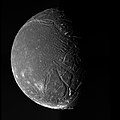Kachina Chasmata

The Kachina Chasmata are the longest known canyon or system of canyons on the surface of the Uranian moon Ariel. The name comes from kachina, a spirit in Hopi mythology.[1] The 622 km long and 50 km wide chasmata arise from a system of normal faults running from the north-west to south-east. The faults bound down-dropped crustal blocks forming structures called graben.[2] The canyons cut the cratered terrain, which means that they were formed at a relatively late stage of the moon's evolution, when the interior of Ariel expanded and its ice crust cracked as a result.[3] The floor of the canyons is not visible on the images obtained by the Voyager 2 spacecraft in January 1986;[2] thus, whether it is covered by smooth plains like the floors of other Arielian graben is currently unknown.[3]
During the Voyager 2 flyby in 1986 the northern hemisphere of Ariel was not illuminated by the Sun because the spacecraft arrived during a southern solstice on Uranus. Nevertheless, because it was still illuminated by light reflected from Uranus, scientists using advanced processing methods were able to detect some details in the dark hemisphere. These analyses revealed a continuation of the Kachina Chasmata into the dark hemisphere, possibly as far as to the opposite limb.[4][5] As the total length of the feature appears to be 1800–2200 km, it may be comparable to Ithaca Chasma on Tethys.[6]
References
Citations
Sources
- USGS/IAU. "Kachina Chasmata on Ariel". Gazetteer of Planetary Nomenclature. USGS Astrogeology. Retrieved 2010-12-02.
- Plescia, J. B. (May 21, 1987). "Geological terrains and crater frequencies on Ariel". Nature. 327 (6119): 201–204. Bibcode:1987Natur.327..201P. doi:10.1038/327201a0. ISSN 0028-0836. S2CID 4324623.
- Smith, B. A.; Soderblom, L. A.; Beebe, A.; Bliss, D.; Boyce, J. M.; Brahic, A.; Briggs, G. A.; Brown, R. H.; Collins, S. A. (4 July 1986). "Voyager 2 in the Uranian System: Imaging Science Results". Science. 233 (4759): 43–64. Bibcode:1986Sci...233...43S. doi:10.1126/science.233.4759.43. PMID 17812889. S2CID 5895824.
- Stooke, P.J. (March 2001). "Voyager Images Revisited: New Views of the Satellites of Saturn and Uranus". 32nd Annual Lunar and Planetary Science Conference, March 12–16, 2001, Houston. Vol. XXXII. Bibcode:2001LPI....32.1074S. Abstract no. 1074.
- Stryk, Ted (2008-03-13). Lakdawalla, Emily (ed.). "Revealing the night sides of Uranus' moons". The Planetary Society Blog. The Planetary Society. Retrieved 2012-02-25.
- Stryk, Ted; Stooke, P.J. (March 10–14, 2008). "Voyager 2 Images of Uranian Satellites: Reprocessing and New Interpretations". 39th Lunar and Planetary Science Conference, (Lunar and Planetary Science XXXIX). League City, Texas. p. 1362. Bibcode:2008LPI....39.1362S.

